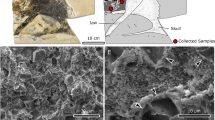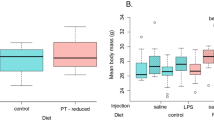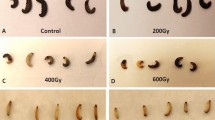Abstract
JORDAN1,2 described the presence of melanic granules in pineal gland of sheep and del Rio-Hortega3–5 found pigment granules in the pinealocytes of human pineal as well as in other mammals. Santamarina and Meyer Arndt6 have more recently shown that the pigment in bovine pineal was true melanin. Ultra-violet spectral curves of bovine pineal melanin showed the same characteristics as those obtained from tyrosine melanin7,8. Pineal melanin differs slightly, however, from the melanin obtained from the choroid of the ox eye. Administration of pineal extract to tadpoles9,10, to toads10 and to fishes11 produces alteration in pigmentation. Thus it is possible that pineal body not only contains melanic pigment but is also capable of inducing some form of change in pigmentation. The hamster pineal body contains pigment granules in abundance (Fig. 1). On the basis of the investigations by Santamarina and Meyer Arndt, these can be assumed to be melanic granules. No data are available at present for the effects of pineal ablation or administration of pineal extract on pigmentation of hamsters. Isolated observations in other species have suggested a possible association between pineal body and pigmentation, however, and therefore a study was undertaken to observe the effect of pineal ablation on the growth and spread of a highly pigmented and spontaneously occurring neoplasm in hamsters.
This is a preview of subscription content, access via your institution
Access options
Subscribe to this journal
Receive 51 print issues and online access
$199.00 per year
only $3.90 per issue
Buy this article
- Purchase on Springer Link
- Instant access to full article PDF
Prices may be subject to local taxes which are calculated during checkout
Similar content being viewed by others
References
Jordan, H. E., Amer. J. Anat., 12, 249 (1911).
Jordan, H. E., Anat. Rec., 22, 275 (1921).
Rio-Hortega, P., del, Arch. Neurol., 3, 359 (1922).
Rio-Hortega, P., del, Arch. Neurol., 9, 26 (1929).
Rio-Hortega, P., del, Arch. Neurol., 9, 139 (1929).
Santamarina, E., and Meyer Arndt, J., Acta Histochem., 3, 1 (1956).
Santamarina, E., and Meyer Arndt, J., Canad. J. Biochem. Physiol., 36, 227 (1958).
Clemo, G. R., and Duxbury, F. K., J. Chem. Soc., 1795 (1950).
Huxley, J. S., and Hogben, L. T., Proc. Roy. Soc., B, 93, 26 (1922).
Bors, O., Rolston, W. C., Proc. Soc. Exp. Biol. and Med., 77, 807 (1951).
Wyman, L. C., J. Exp. Zool., 40, 161 (1924).
Das Gupta, T., and Terz, J., (submitted for publication).
Fortner, J. G., Mahy, A. G., and Schrodt, G., Cancer Res., 21 (Suppl.) 161 (1961).
Author information
Authors and Affiliations
Rights and permissions
About this article
Cite this article
DAS GUPTA, T., TERZ, J. Influence of Pineal Body on Melanoma of Hamsters. Nature 213, 1038–1040 (1967). https://doi.org/10.1038/2131038a0
Issue Date:
DOI: https://doi.org/10.1038/2131038a0
This article is cited by
-
Effects of growing tumours on pineal melatonin levels in male rats
Journal of Neural Transmission (1981)
Comments
By submitting a comment you agree to abide by our Terms and Community Guidelines. If you find something abusive or that does not comply with our terms or guidelines please flag it as inappropriate.



